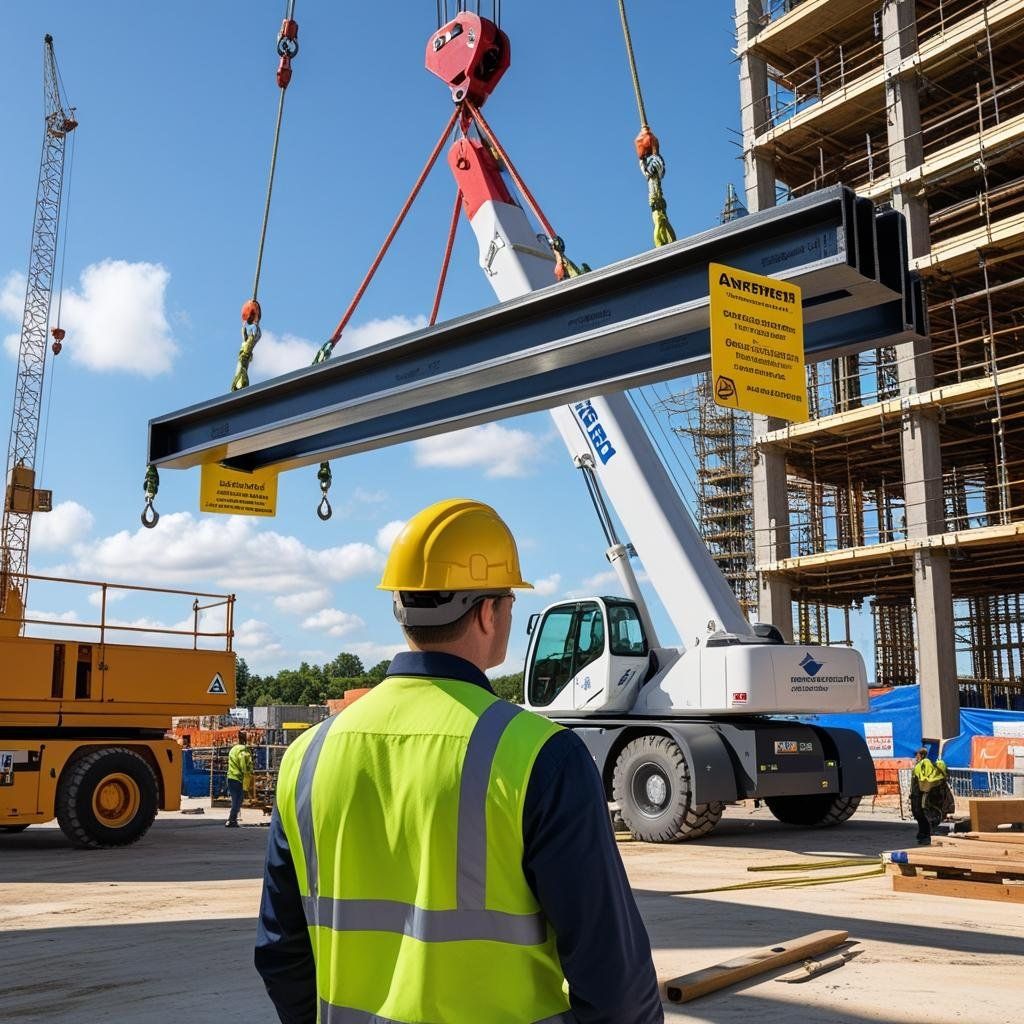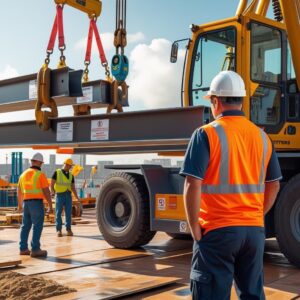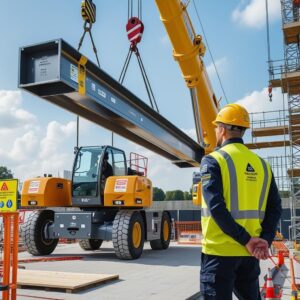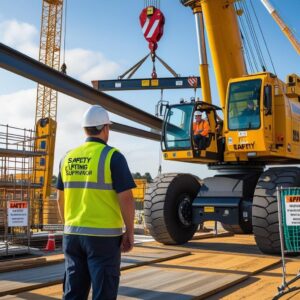Introduction
The role of a Lifting Supervisor is crucial in ensuring the safety and efficiency of lifting operations across various industries. This comprehensive guide provides a detailed overview of a Lifting Supervisor Course, covering its objectives, syllabus, safety regulations, responsibilities, assessment methods, and certification details. This course equips individuals with the necessary knowledge and skills to effectively plan, supervise, and execute lifting operations in compliance with industry standards and best practices.

Safe lifting practices are paramount to prevent accidents, injuries, and damage to equipment and property. A well-trained Lifting Supervisor plays a vital role in mitigating risks associated with lifting operations, ensuring that all personnel involved are aware of potential hazards and follow established safety protocols. This course aims to provide a thorough understanding of these critical aspects.
Course Objectives
Upon completion of the Lifting Supervisor Course, participants will be able to:
Understand and apply relevant legislation and industry standards: This includes a thorough knowledge of local and international regulations governing lifting operations.
Develop and implement safe lifting plans: Participants will learn how to assess risks, select appropriate equipment, and create detailed lifting plans.
Supervise lifting operations effectively: This involves overseeing the execution of lifting plans, ensuring adherence to safety protocols, and managing personnel involved in the operation.
Conduct pre-lift inspections: Participants will learn how to inspect lifting equipment and accessories to identify potential defects and ensure their safe operation.
Communicate effectively with lifting teams: Clear and concise communication is essential for safe lifting operations. Participants will learn how to communicate instructions, warnings, and feedback effectively.
Identify and mitigate potential hazards: This includes recognizing potential risks associated with lifting operations and implementing appropriate control measures.
Respond effectively to emergencies: Participants will learn how to respond to accidents and incidents involving lifting operations, including first aid and emergency procedures.
Promote a culture of safety: A proactive approach to safety is essential for preventing accidents. Participants will learn how to foster a safety-conscious environment among lifting teams.
Course Syllabus and Modules
The Lifting Supervisor Course is typically structured into several modules, each covering a specific aspect of lifting operations. The following is a detailed overview of the modules and their content:
Module 1: Introduction to Lifting Operations
Overview of lifting operations and their importance
Roles and responsibilities of personnel involved in lifting operations (Lifting Supervisor, Riggers, Operators, etc.)
Basic principles of lifting and rigging
Common hazards associated with lifting operations
Module 2: Legislation and Standards
Relevant national and international legislation (e.g., LOLER, PUWER, OSHA)
Industry standards and best practices (e.g., ASME, BS)
Understanding legal responsibilities and liabilities
Compliance requirements for lifting operations
Module 3: Lifting Equipment and Accessories
Types of lifting equipment (cranes, hoists, forklifts, etc.)
Lifting accessories (slings, shackles, hooks, etc.)
Inspection, maintenance, and certification of lifting equipment and accessories
Safe use and operation of lifting equipment and accessories
Module 4: Lifting Plans and Risk Assessment
Developing a comprehensive lifting plan
Risk assessment methodologies (e.g., HAZID, HAZOP)
Identifying hazards and implementing control measures
Factors to consider when planning a lift (load weight, center of gravity, environmental conditions, etc.)
Module 5: Safe Lifting Techniques
Proper rigging techniques
Load securing and stability
Communication signals and hand signals
Working at height safety
Confined space lifting
Module 6: Supervision and Communication

Effective supervision techniques
Communication protocols for lifting teams
Briefing and debriefing procedures
Conflict resolution and problem-solving
Module 7: Emergency Procedures
Emergency response plans
First aid for lifting-related injuries
Incident reporting and investigation
Equipment malfunction procedures
Module 8: Practical Exercises and Simulations
Hands-on exercises using lifting equipment and accessories
Simulated lifting scenarios to reinforce learning
Teamwork and communication exercises
Assessment of practical skills and competence
Detailed Breakdown of Key Modules
Let’s delve deeper into some of the crucial modules within the Lifting Supervisor Course:
Lifting Plans and Risk Assessment (Module 4):
This module focuses on the critical process of planning lifting operations and assessing the associated risks. A well-developed lifting plan is essential for ensuring the safety and efficiency of any lifting operation. The module covers the following key aspects:
Developing a Lifting Plan: A lifting plan is a detailed document that outlines all aspects of a lifting operation, including the equipment to be used, the procedures to be followed, and the potential hazards involved. The module teaches participants how to create a comprehensive lifting plan that addresses all relevant factors.
Risk Assessment: Identifying and assessing the risks associated with lifting operations is crucial for preventing accidents. This module introduces participants to various risk assessment methodologies, such as HAZID (Hazard Identification) and HAZOP (Hazard and Operability Study). Participants learn how to identify potential hazards, assess the likelihood and severity of each hazard, and implement appropriate control measures to mitigate the risks.
Factors to Consider: When planning a lift, it is essential to consider a wide range of factors, including the weight and dimensions of the load, the center of gravity of the load, the environmental conditions (e.g., wind speed, temperature), the availability of suitable lifting equipment, and the presence of any obstructions or overhead hazards. This module helps participants understand these factors and how they can impact the safety of the lifting operation.
Safe Lifting Techniques (Module 5):
This module focuses on the practical skills and techniques required to perform lifting operations safely. It covers the following key aspects:
Rigging Techniques: Proper rigging is essential for ensuring the stability and security of the load during lifting. This module teaches participants how to select and use different types of rigging equipment, such as slings, shackles, and hooks, and how to connect them properly to the load and the lifting equipment.
Load Securing: Securing the load properly is crucial for preventing it from shifting or falling during lifting. This module covers different methods of load securing, such as using straps, chains, and clamps, and how to select the appropriate method for different types of loads.
Communication Signals: Clear and concise communication is essential for safe lifting operations. This module teaches participants the standard communication signals and hand signals used in lifting operations, ensuring that all members of the lifting team can communicate effectively.
Supervision and Communication (Module 6):
Effective supervision and communication are crucial for ensuring the safety and efficiency of lifting operations. This module covers the following key aspects:
Supervision Techniques: A Lifting Supervisor must be able to effectively supervise the lifting operation, ensuring that all personnel follow safety protocols and that the lifting plan is executed correctly. This module teaches participants effective supervision techniques, such as monitoring the lifting operation, providing clear instructions, and addressing any problems or concerns that arise.
Communication Protocols: Establishing clear communication protocols is essential for ensuring that all members of the lifting team can communicate effectively. This module covers the different communication channels that can be used in lifting operations, such as radio communication, hand signals, and verbal communication.
Briefing and Debriefing: Briefing the lifting team before the operation and debriefing them afterwards is crucial for ensuring that everyone understands their roles and responsibilities and that any lessons learned are captured. This module teaches participants how to conduct effective briefings and debriefings.
Emergency Procedures (Module 7):
Despite the best planning and precautions, accidents can still occur during lifting operations. This module focuses on the procedures to follow in the event of an emergency. It covers the following key aspects:
Emergency Response Plans: Developing a comprehensive emergency response plan is essential for ensuring that everyone knows what to do in the event of an accident. This module teaches participants how to develop an emergency response plan that addresses different types of emergencies, such as equipment failure, load instability, and personnel injuries.
First Aid: Knowing how to administer first aid is crucial for providing immediate care to injured personnel. This module covers the basic principles of first aid and how to treat common lifting-related injuries, such as cuts, bruises, and fractures.
Incident Reporting and Investigation: Reporting and investigating incidents is essential for identifying the root causes of accidents and preventing them from happening again. This module teaches participants how to report incidents and how to conduct a thorough investigation to determine the causes of the accident.
Safety Regulations and Best Practices
The Lifting Supervisor Course emphasizes adherence to safety regulations and best practices to minimize risks associated with lifting operations. Key safety regulations include:
LOLER (Lifting Operations and Lifting Equipment Regulations): These regulations cover the safe use of lifting equipment and accessories, including inspection, maintenance, and thorough examination.
PUWER (Provision and Use of Work Equipment Regulations): These regulations ensure that work equipment is safe to use, properly maintained, and used by competent persons.
OSHA (Occupational Safety and Health Administration) Standards: OSHA standards provide guidelines for safe lifting practices in the United States, covering various aspects of lifting operations.
Best practices include:
Pre-lift inspections: Thoroughly inspect lifting equipment and accessories before each lift to identify any defects or damage.
Proper rigging techniques: Use appropriate rigging techniques to ensure the load is securely attached to the lifting equipment.
Load stability: Ensure the load is stable and properly balanced before lifting.
Communication: Maintain clear and concise communication between all members of the lifting team.
Emergency preparedness: Develop and implement emergency response plans to address potential accidents and incidents.
Competent personnel: Ensure that all personnel involved in lifting operations are properly trained and competent.
Responsibilities of a Lifting Supervisor

The Lifting Supervisor has several critical responsibilities to ensure the safety and efficiency of lifting operations. These responsibilities include:
Planning and Risk Assessment: Developing a comprehensive lifting plan and conducting a thorough risk assessment to identify potential hazards and implement control measures.
Equipment Inspection: Ensuring that all lifting equipment and accessories are inspected before use and are in good working condition.
Supervision: Overseeing the execution of the lifting plan, ensuring adherence to safety protocols, and managing personnel involved in the operation.
Communication: Maintaining clear and concise communication with the lifting team, providing instructions, warnings, and feedback as needed.
Emergency Response: Responding effectively to emergencies, providing first aid, and implementing emergency procedures.
Compliance: Ensuring that all lifting operations comply with relevant legislation, industry standards, and best practices.
Training and Competence: Ensuring that all personnel involved in lifting operations are properly trained and competent to perform their assigned tasks.
Documentation: Maintaining accurate records of lifting operations, including lifting plans, risk assessments, inspection reports, and training records.
Assessment Methods
The Lifting Supervisor Course typically employs a combination of assessment methods to evaluate participants’ knowledge, skills, and competence. These methods include:
Written Examinations: Assessing participants’ understanding of legislation, industry standards, and best practices.
Practical Assessments: Evaluating participants’ ability to perform lifting operations safely and efficiently, including rigging, load securing, and communication.
Case Studies: Analyzing real-world scenarios to assess participants’ ability to apply their knowledge and skills to solve problems and make informed decisions.
Simulations: Conducting simulated lifting operations to evaluate participants’ ability to respond to emergencies and manage complex situations.
Group Projects: Working in teams to develop lifting plans and risk assessments, assessing participants’ ability to collaborate and communicate effectively.
Observation: Observing participants during practical exercises to assess their competence in performing lifting tasks safely and efficiently.
Successful completion of the course requires participants to demonstrate competence in all assessment areas.
Certification Details
Upon successful completion of the Lifting Supervisor Course, participants will receive a certification that validates their competence in supervising lifting operations. The certification typically includes:
Course Completion Certificate: A formal document certifying that the participant has successfully completed the course and met all requirements.
Competency Card: A wallet-sized card that provides proof of certification and can be used to verify the participant’s qualifications.
Record of Training: A detailed record of the training received, including the modules covered, assessment methods used, and the participant’s performance.
The certification is typically valid for a specific period, after which participants may need to undergo refresher training to maintain their competence. The certification may be recognized by employers, regulatory agencies, and industry organizations.

Industry Standards and Best Practices
The Lifting Supervisor Course aligns with relevant industry standards and best practices to ensure that participants receive the most up-to-date and relevant training. Key standards and best practices include:
ASME (American Society of Mechanical Engineers) Standards: ASME standards provide guidelines for the design, construction, inspection, and maintenance of lifting equipment and accessories.
BS (British Standards) Standards: BS standards provide similar guidelines for lifting equipment and accessories in the United Kingdom.
ISO (International Organization for Standardization) Standards: ISO standards provide international guidelines for various aspects of lifting operations.
Lifting Equipment Engineers Association (LEEA) Guidance: LEEA provides guidance and best practices for the safe use and inspection of lifting equipment.
The course curriculum is regularly updated to reflect changes in industry standards and best practices.
Benefits of Completing the Course
Completing a Lifting Supervisor Course offers numerous benefits for individuals and organizations, including:
Enhanced Safety: Improved knowledge and skills in safe lifting practices, reducing the risk of accidents and injuries.
Increased Efficiency: Streamlined lifting operations, leading to improved productivity and reduced downtime.
Compliance: Ensuring compliance with relevant legislation, industry standards, and best practices.
Improved Reputation: Demonstrating a commitment to safety, enhancing the organization’s reputation.
Career Advancement: Providing individuals with the qualifications and skills needed to advance their careers in the lifting industry.
Reduced Costs: Minimizing the costs associated with accidents, injuries, and equipment damage.
Greater Confidence: Equipping Lifting Supervisors with the knowledge and skills to perform their roles with confidence and competence.
Target Audience
This Lifting Supervisor Course is designed for individuals who are responsible for planning, supervising, and executing lifting operations. This includes:
Lifting Supervisors: Individuals who directly oversee lifting operations on a day-to-day basis.
Construction Managers: Managers responsible for overseeing construction projects that involve lifting operations.
Site Foremen: Foremen responsible for supervising work crews on construction sites.
Safety Officers: Officers responsible for ensuring the safety of workers on construction sites and other workplaces.
Riggers: Individuals who are responsible for rigging and securing loads for lifting.
Crane Operators: Operators who operate cranes and other lifting equipment.
Engineers: Engineers who are involved in the design and planning of lifting operations.
Anyone Involved in Lifting Operations: Any individual who is involved in lifting operations and wants to improve their knowledge and skills in safe lifting practices.
Course Prerequisites
While specific prerequisites may vary depending on the training provider, some common prerequisites for the Lifting Supervisor Course include:
Age Requirement: Most courses require participants to be at least 18 years of age.
Literacy and Numeracy: Participants should have a basic understanding of literacy and numeracy to be able to comprehend course materials and perform calculations related to lifting operations.
Industry Experience: Some courses may require participants to have a certain amount of experience in the lifting industry or a related field.
Basic Safety Training: Participants may be required to have completed basic safety training courses, such as a general safety induction or a working at heights course.
Medical Fitness: Participants may be required to undergo a medical assessment to ensure that they are physically fit to perform the duties of a Lifting Supervisor.
The Future of Lifting Supervision
The field of lifting supervision is constantly evolving, driven by technological advancements, changing regulations, and a growing emphasis on safety. Some of the key trends shaping the future of lifting supervision include:
Increased Use of Technology: Technology is playing an increasingly important role in lifting operations, with the introduction of new equipment, such as drones, robots, and advanced sensors. Lifting Supervisors will need to be proficient in using these technologies to enhance safety and efficiency.
Greater Emphasis on Data Analysis: Data analysis is being used to identify trends and patterns in lifting operations, allowing for more proactive risk management. Lifting Supervisors will need to be able to analyze data and use it to improve safety performance.
Focus on Sustainability: There is a growing emphasis on sustainability in all industries, including the lifting industry. Lifting Supervisors will need to be aware of the environmental impact of lifting operations and implement practices to minimize it.
Increased Regulation: Regulations governing lifting operations are becoming increasingly stringent, driven by a desire to improve safety and protect the environment. Lifting Supervisors will need to stay up-to-date with the latest regulations and ensure that their operations comply with them.
Shift Towards Virtual Reality Training: Virtual reality (VR) training is becoming incre

